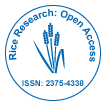Sustainable Rice Cultivation and Climate Change Adaptation
Received: 02-Nov-2024 / Manuscript No. rroa-25-158949 / Editor assigned: 04-Nov-2024 / PreQC No. rroa-25-158949(PQ) / Reviewed: 18-Nov-2024 / QC No. rroa-25-158949 / Revised: 23-Nov-2024 / Manuscript No. rroa-25-158949 (R) / Published Date: 28-Nov-2024
Abstract
Climate change poses a significant threat to global rice production, particularly in regions dependent on rain-fed agriculture. In this research, we examine sustainable rice cultivation practices and their potential to mitigate the impacts of climate change. The study focuses on various approaches such as water management techniques, crop rotation, and the use of climate-resilient rice varieties. The findings suggest that integrated approaches to rice farming, combining ecological and agronomic practices, are crucial for adapting to changing climate conditions and ensuring food security.
Keywords
Climate Change; Rice Cultivation; Sustainable Farming; Adaptation; Water Management
Introduction
Rice is one of the most important crops worldwide, providing food for billions of people, especially in Asia. However, rice cultivation is highly sensitive to environmental factors such as temperature, rainfall, and water availability, all of which are increasingly affected by climate change. Climate models predict rising temperatures, more frequent droughts, and erratic rainfall patterns, which threaten to reduce rice yields and the livelihoods of millions of smallholder farmers. In regions where rice is grown under rain-fed conditions, farmers are particularly vulnerable to these climatic shifts. To ensure global food security, it is essential to adapt rice cultivation to the changing climate. Sustainable farming practices that increase the resilience of rice farming systems to climate change are critical. This includes improving water use efficiency, developing drought-tolerant rice varieties, and adopting integrated farming techniques such as crop rotation, agroforestry, and organic farming. The integration of ecological farming practices with conventional agronomy could also reduce reliance on chemical inputs, decrease environmental degradation, and enhance the long-term sustainability of rice farming. This research explores various sustainable rice cultivation strategies and their potential to mitigate the negative impacts of climate change on rice production. By focusing on practices such as improved water management, the use of climate-resilient rice varieties, and ecosystem-based approaches, this article aims to provide practical solutions that can help farmers adapt to climate change while maintaining or even increasing rice yields. As the effects of climate change intensify, the development of resilient agricultural systems will be critical in ensuring food security for the growing global population [1-5].
Discussion
One of the primary challenges posed by climate change is the increased frequency of droughts and erratic rainfall. Water scarcity directly affects rice cultivation, which traditionally requires large amounts of water for optimal growth. Sustainable water management practices, such as alternate wetting and drying (AWD), have been shown to reduce water use while maintaining rice yields. AWD, a practice where rice fields are intermittently flooded, helps conserve water and minimize methane emissions, contributing to more sustainable farming practices. In addition to water management, the use of climate-resilient rice varieties is another important adaptation strategy. Recent breeding programs have focused on developing rice varieties that are more tolerant to both drought and heat stress. For example, varieties with enhanced root systems and more efficient use of water have shown improved performance in drought-prone regions. Crop rotation is another sustainable practice that can improve soil fertility and break pest cycles. Rotating rice with legumes or other crops helps to reduce soil degradation and dependence on chemical fertilizers, while also promoting biodiversity. Moreover, integrated pest management (IPM) strategies can reduce reliance on chemical pesticides, fostering a more balanced and sustainable ecosystem [6-10].
Conclusion
Climate change poses significant risks to rice production, but a combination of sustainable farming practices can help mitigate these impacts. Strategies such as water conservation techniques, the use of drought- and heat-tolerant rice varieties, and crop rotation are essential for adapting to changing climatic conditions. By integrating ecological and agronomic approaches, rice farming systems can become more resilient and sustainable, ensuring the continued availability of this vital staple crop in the face of climate change.
References
- Leung DYC, Wu X, Leung MKH (2010)A reviews on biodiesel production using catalyzed Tran’s esterification. Appl Energy 87: 1083-1095.
- Meher LC, Sagar DV, Naik SN (2006)Technical aspects of biodiesel production by Tran’s esterification - A review. Renew Sustain Energy Rev 10: 248-268.
- Anamika G, Saumya D, Mazumder A (2021)Updated Review on Ethno medicinal Plant Caryota urens. Int J Pharm Res 13: 101-105.
- Zehr BE, Eckhoft S R, Singh S I C, Keeling P L (1995)Comparison of wet milling properties among maize inbred lines and their hybrids. Cereal Chem 72: 491-497.
- Wijesinghe J A A C, Wickramasinghe I, Saranandha K (2015)Kithul Flour (Caryota urens) as a Potential Flour Source for Food Industry. Am J Food Technol 3: 10-18.
- Toole BP (2001)Hyaluronan in morphogenesis. Semin Cell Dev Biol 12:79-87.
- Allison D, Grande-Allen K (2006)Hyaluronan: a powerful tissue engineering tool. Biomaterials 12:2131-2140.
- Philip JM, Mahalakshmi K (2019)Antimicrobial effect of three Indian medicinal plant extracts on common denture plaque bacteria. Drug Discov Today 11(3): 584-586.
- Geetha S, Vasuki R (2019)Anticancer activity of Cissus quadrangularis. Int j eng innov technol 8: 603- 605.
- Anbuselvi S, Roshini Esther A, Punithavathy R (2019)In-vitro anti-urolithiatic activity of Theriophonum minutum and Remusatia vivipara. Int J Recent Technol Eng 8: 3088-3091.
